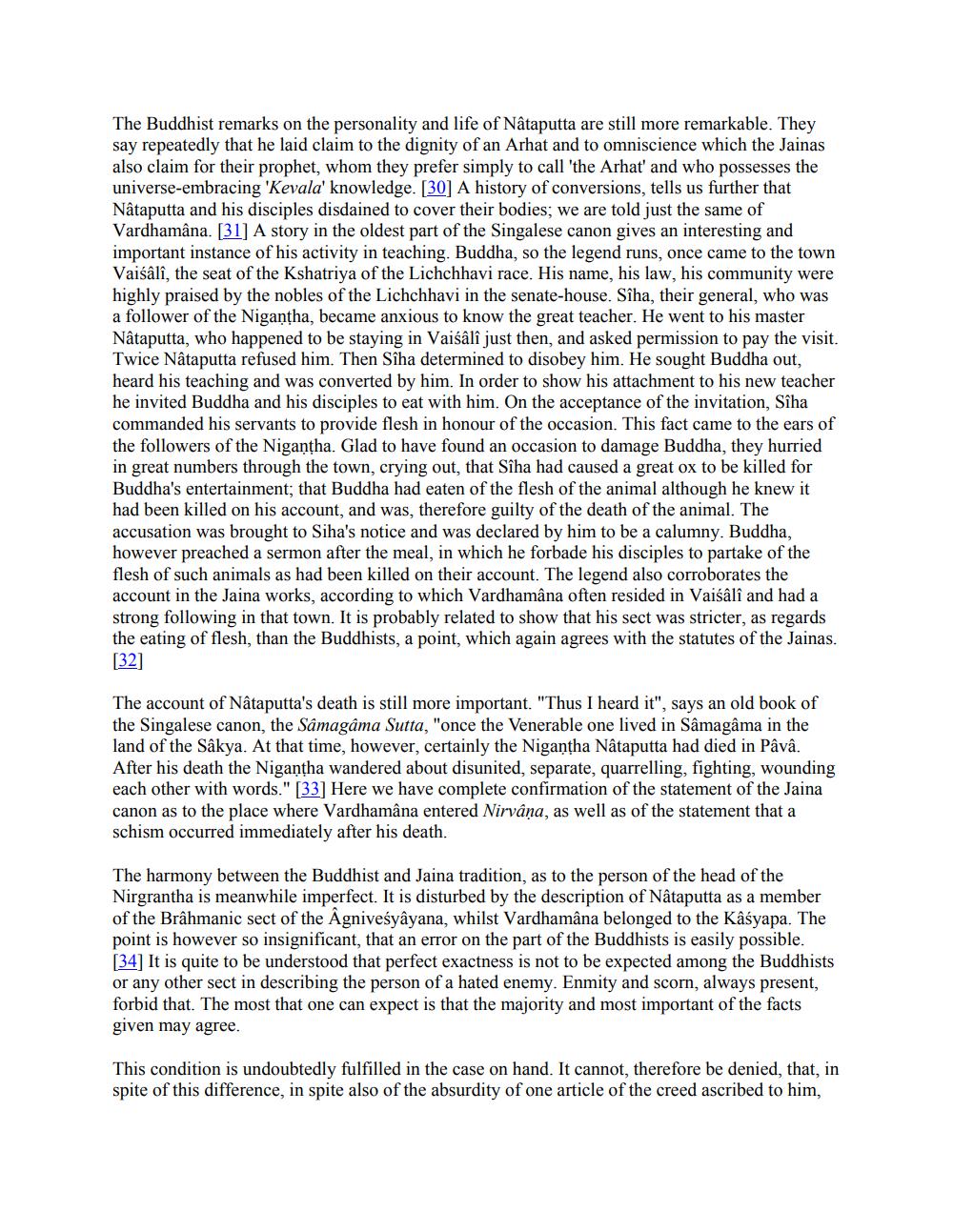________________
The Buddhist remarks on the personality and life of Nâtaputta are still more remarkable. They say repeatedly that he laid claim to the dignity of an Arhat and to omniscience which the Jainas also claim for their prophet, whom they prefer simply to call 'the Arhat' and who possesses the universe-embracing 'Kevala' knowledge. [30] A history of conversions, tells us further that Nâtaputta and his disciples disdained to cover their bodies, we are told just the same of Vardhamâna. [31] A story in the oldest part of the Singalese canon gives an interesting and important instance of his activity in teaching. Buddha, so the legend runs, once came to the town Vaisâlî, the seat of the Kshatriya of the Lichchhavi race. His name, his law, his community were highly praised by the nobles of the Lichchhavi in the senate-house. Sîha, their general, who was a follower of the Nigantha, became anxious to know the great teacher. He went to his master Nâtaputta, who happened to be staying in Vaisalî just then, and asked permission to pay the visit. Twice Nâtaputta refused him. Then Sîha determined to disobey him. He sought Buddha out, heard his teaching and was converted by him. In order to show his attachment to his new teacher he invited Buddha and his disciples to eat with him. On the acceptance of the invitation, Sîha commanded his servants to provide flesh in honour of the occasion. This fact came to the ears of the followers of the Nigantha. Glad to have found an occasion to damage Buddha, they hurried in great numbers through the town, crying out, that Sîha had caused a great ox to be killed for Buddha's entertainment; that Buddha had eaten of the flesh of the animal although he knew it had been killed on his account, and was, therefore guilty of the death of the animal. The accusation was brought to Siha's notice and was declared by him to be a calumny. Buddha, however preached a sermon after the meal, in which he forbade his disciples to partake of the flesh of such animals as had been killed on their account. The legend also corroborates the account in the Jaina works, according to which Vardhamâna often resided in Vaiśâlî and had a strong following in that town. It is probably related to show that his sect was stricter, as regards the eating of flesh, than the Buddhists, a point, which again agrees with the statutes of the Jainas.
[32]
The account of Nâtaputta's death is still more important. "Thus I heard it", says an old book of the Singalese canon, the Samagama Sutta, "once the Venerable one lived in Samagama in the land of the Sakya. At that time, however, certainly the Nigantha Nataputta had died in Pâvâ. After his death the Nigantha wandered about disunited, separate, quarrelling, fighting, wounding each other with words." [33] Here we have complete confirmation of the statement of the Jaina canon as to the place where Vardhamâna entered Nirvana, as well as of the statement that a schism occurred immediately after his death.
The harmony between the Buddhist and Jaina tradition, as to the person of the head of the Nirgrantha is meanwhile imperfect. It is disturbed by the description of Nâtaputta as a member of the Brahmanic sect of the Agnivesyâyana, whilst Vardhamana belonged to the Kaśyapa. The point is however so insignificant, that an error on the part of the Buddhists is easily possible. [34] It is quite to be understood that perfect exactness is not to be expected among the Buddhists or any other sect in describing the person of a hated enemy. Enmity and scorn, always present, forbid that. The most that one can expect is that the majority and most important of the facts given may agree.
This condition is undoubtedly fulfilled in the case on hand. It cannot, therefore be denied, that, in spite of this difference, in spite also of the absurdity of one article of the creed ascribed to him,




